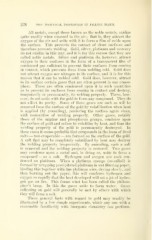Page 492 - My FlipBook
P. 492
228 THE TECHNICAIi PEOCEDUEES IN FILLING TEETH.
All metals, except those kno'RTi as tlie noble metals, oxidize
quite readily when exposed to the air; that is, they attract the
oxygen of the air and unite with it to form a film of oxide upon
the surface. This prevents the contact of clean surfaces and
therefore prevents welding. Gold, silver, platinum and mercury
do not oxidize in this way, and it is for this reason that they are
called noble metals. Silver and platinum do, however, attract
oxygen to their surfaces in the form of a transpai'ent film of
condensed gas sufficient to prevent their surfaces from coming
in contact, which prevents them from welding cold. Gold does
not attract oxj^gen nor nitrogen to its surface, and it is for this
reason that it can be welded cold. Gold does, however, attract
to its surface certain gases that are often present in our atmos-
phere. These are often condensed upon it in such quantities
as to prevent its surfaces from coming in contact and destroy,
temporarily or permanently, its welding property. These, how-
ever, do not imite with the gold to form any compound. They do
not affect its purity. Some of these gases are such as will be
removed from the surface of the gold by volatilization when heat
is applied (by annealing), rendering the surface again clean,
with restoration of welding property. Other gases, notably
those of the sulphur and phosphorus groups, condense upon
the surface of gold and refuse to volatilize by heat, and thus the
welding property of the gold is permanently destroyed. In
these cases it seems probable that compounds in the form of fixed
salts — non-evaporable — are formed on the surface of the gold.
A salt that may be completely volatilized by heat may destroy
the welding property temporarily. By annealing, such a salt
is removed and the welding property is restored. Two gases
may condense upon a metal and, in doing so, unite to form a
compound— as a salt. Hydrogen and oxygen are each con-
densed on platinum. When a platinum sponge (so-called) is
formed by wrapping precipitated platinum in wet filtering paper,
binding this together with fine platinum wire, drying slowly, and
then burning out the paper, this will condense hydrogen and
oxygen so rapidly that the heat developed will set a jet of hydro-
gen gas on fire. This forms what has been called the philoso-
pher's lamp. In this the gases unite to form water. Gases
collecting on gold will generally be met by others with which
they will form a salt.
These general facts with regard to gold may readily be
illustrated by a few simple experiments, which any one with a
reasonable familiarity with inorganic chemistry can perform.


